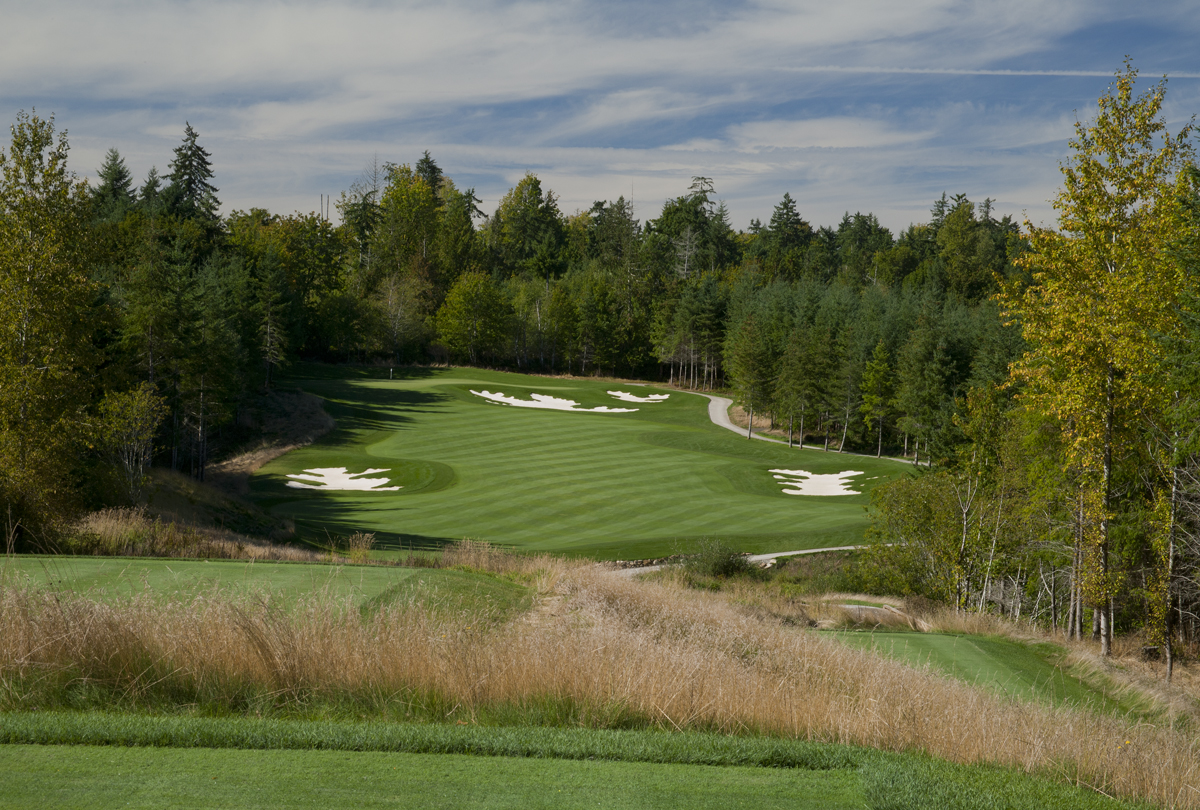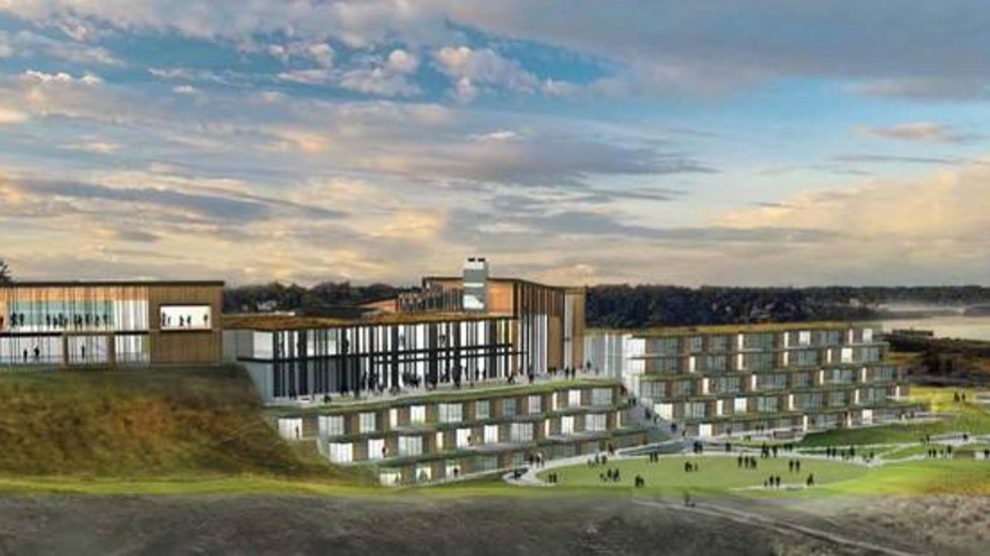When Pierce County officials broke ground at Chambers Bay on Oct. 11, 2005, all Northwest golf writers could think about was how Robert Trent Jones Jr. was going to transform 250 acres of unsightly, unused sand quarry into the world-class golf course of their dreams.
Could this course possibly become the money-making, public-access facility County Executive John Ladenburg insisted it would be? And could it ever realize his dream of one day hosting a major championship?
Besides the golf course though, there was also the question of what else the project might involve. Was there going to be a hotel, restaurants and all the other on-site amenities you’d expect to see alongside a big money, highly publicized course -- facilities that would reduce the $24 million construction debt, while adding to its prestige?
The intensity surrounding the subject of accommodations and infrastructure became a hot -- really hot -- issue when it was announced on June 13, 2008, that Chambers Bay had been awarded the 2015 U.S. Open.
Where on Earth would the tens of thousands of people coming to watch the event stay? What about the multi-millionaire golfers arriving by private jet? Regardless of what they thought of the course, and no matter how wonderful the views over Puget Sound were, their impression of the area might be tainted somewhat if forced to spend the week in a budget chain hotel.
Four proposals for a $35 million development, each which included a 120-plus-room hotel, were submitted from companies in Tacoma and Bellevue in Washington as well as from Calgary in Canada, and Northbrook, Ill.-based KemperSports –- the management firm that ran the golf course (and still does).
The rotting economy destroyed those plans, however, so players and spectators had to make do with what was available, renting houses and taking rooms in Tacoma, Seattle and wherever else they could find one.
Plans for on-site lodging were revisited in 2014 when Los Angeles developer Robert Sonnenblick put forward a $120 million proposal that included a 258-room hotel plus a second golf course. But construction wouldn’t begin until after the U.S. Open, and Pierce County and Sonnenblick eventually broke off negotiations anyway, with the County saying the second course could possibly prevent the USGA from returning and Sonnenblick saying the much smaller development the County seemed to want didn’t make any sense.
“What they’re now planning is a very small, inconsequential development that we’re not interested in,” he told the Tacoma-based News-Tribune in January.
Interest from developers was sought again, and in August it was announced just two firms had submitted plans for a scaled-down development -- one from a Puyallup construction firm named Absher Construction Co., which teamed with local accountant Dan Putnam (father of pro golfers Michael and Andrew), the other from Florida-based Valiant Washington, a development company owned by businessman William Haberman.
Valiant’s $50 million plan called for a 124-unit hotel with a 20,000-square-foot restaurant, a 30,000-square-foot clubhouse and a view restaurant where the current clubhouse is located. A golf academy, practice facility and open-air plaza were also proposed. However, on Oct. 17, Pat McCarthy, who succeeded Ladenburg as Pierce County Executive in 2009, selected the Absher/Putnam bid which she said was “more cohesive," and “provided less risk."
Chambers Bay Development LLC made the most of the local angle, including a Tom Douglas restaurant -- the first outside of Seattle -- in its plan, Seattle-based Columbia Hospitality, GGLO Architects and KemperSports. Its proposed 80-room hotel would include six spa treatment rooms and the 200-seat Tom Douglas restaurant. Improvements would be made to existing public areas, and a 5,000-square-foot outdoor event space would be built. Eighty villas would also be constructed below the hotel, though proposals for additional villas on Grandview Avenue above the eighth fairway were rejected because of public disapproval.
Tony Tipton, Director of County Parks and Recreation, says the county is just now beginning its negotiations with the selected team, adding he is hopeful an agreement acceptable to the County Council will be approved before the end of the year. If the council rejects the plan, however, Valiant Washington will be recalled, and the negotiation phase will begin again.
Tipton notes that after the Sonnenblick proposal was finally discarded, the county made a conscious effort to prohibit a second golf course.
“We also expressed a desire for a project that was more compatible with the site’s natural aesthetic,” he adds.
Last week, Tipton told the News-Tribune he thought Absher and Putnam better understood the Pacific Northwest, and that ultimately their development would be “something the community can be proud of."
Assuming an agreement is reached, construction would probably begin in spring of 2017, says Tipton, with a completion date sometime in 2019, shortly after Chambers Bay hosts its third USGA event – the U.S. Amateur Four-Ball Championship – at the end of May.
Whether the hotel development goes ahead or not (and it certainly wouldn’t be before time if it did), Chambers Bay remains a course you simply must play. For starters, it really is extraordinary, unlike anything you’ve played before. But you also have to play there because you want to be part of the conversation surrounding it: Is Chambers Bay the most exciting course built in America in the last 50 years, or is it, as Gary Player opined during the U.S. Open, "a tragedy," and "basically unplayable?"
“It's 7,900 yards long,” Player ranted. “The world is in dire straits with water. Can you imagine the costs to maintain this? And it's a public course, but they'll probably charge the public $200 to play it. I'd like to challenge anyone with a 16 handicap to do better than 40 over par.”
Player, one of the greatest golfers in the game’s history, is entitled to an opinion, of course -- he’s earned it. But he’s wrong about the water Chambers Bay consumes. And any course set up for a U.S. Open is going to be monstrously difficult for a 16-handicapper.
In response to Player’s outburst, the course’s designer, Robert Trent Jones Jr., said Chambers Bay costs less than a third to maintain than Player’s beloved Augusta National. The fact it records four or five times as many rounds as ANGC says a lot about the demands Augusta National makes on its maintenance crew and operating budget -- and those Chambers Bay doesn’t.
General Manager Matt Allen says each irrigated acre at Chambers Bay receives roughly 360,000 gallons of water a year which equates to just under 100,000 gallons a day for the entire course – a tenth of what some Arizona desert courses receive. Golfers from outside the Pacific Northwest who saw it for the first time during last year’s U.S. Open no doubt got entirely the wrong impression (not unlike Gary Player) and will be in no hurry to schedule a tee time. It didn’t rain in University Place for weeks prior to the championship, and it remained hot and dry for all four days of the tournament. With no irrigation and the USGA’s typically stringent set-up -- for the public, the greens were kept at two-tenths of an inch, but they were cut to 14-hundredths for the championship -- it’s hardly surprising Chambers Bay was a bouncy, unforgiving, relentlessly demanding test. What was surprising -- totally incredible in fact -- was that anyone was able to finish under par, let alone the 5-under 275 winner Jordan Spieth managed.
Allen says the cutting height rose slightly immediately following the U.S. Open to bring the turf back from the brink, but that they are now being mowed at the same height as they were for the US Open.
“But they are very different to U.S. Open greens,” he says. “With rain and sprinkler irrigation, they are quite a bit slower, a different color and just more player-friendly.”
Part of the Chambers Bay conversation concerns the future and what happens to the putting surfaces now. Many called for the fescue to be ripped up and the greens sowed with Bentgrass. Allen says that won’t happen, and that over time the surfaces will inevitably transition to poa annua.
“Universal wisdom says the poa will prevail,” he adds. “Pebble Beach and Oakmont have all-poa greens so it’s not unprecedented for major championship venues. But ours will be different because of the fescue base and because there are so many different strains of poa.”
Chambers Bay’s greens will therefore have a mottled effect, says Allen, but will roll well with constant monitoring. The maintenance crew, headed by Director of Agronomy Eric Johnson, will also continue to overseed with Colonial Bent periodically to improve roll and color.

In addition to Chambers Bay, any trip to the Northwest should include a stop at the gorgeous Gene Bates-designed Salish Cliffs where there are no such worries about the greens. An hour’s drive from Chambers Bay, Salish Cliffs just celebrated its fifth birthday and has the best putting surfaces I’ve seen all year, by far.
Superintendent Bob Pearsall says Salish’s great summer greens start with successful spring aerification.
“We frequently roll prior to aerification in order to compact the soil which gives us a good pull of the cores,” he says. “During summer, we use a combination of directional-rolling and daily switches of mowing patterns. We walk-mow and use a prism/scope to check the quality of cut. We also do light topdressings and verti-cutting when needed.”
Pearsall meets with his staff on the practice putting green every morning, and, as they putt, they discuss the plan for the day.
“We don’t get to play as often as we like,” says Pearsall, “so this is a great way to see how the greens are rolling. The key is walking the greens every day, and seeing what they need or how hard you can push them.”
Cut from a deep, coniferous forest and built on an old sand quarry bordering Puget Sound, Salish Cliffs and Chambers Bay look as different as two golf courses can. But who cares where they come from, you’ll love them both.

